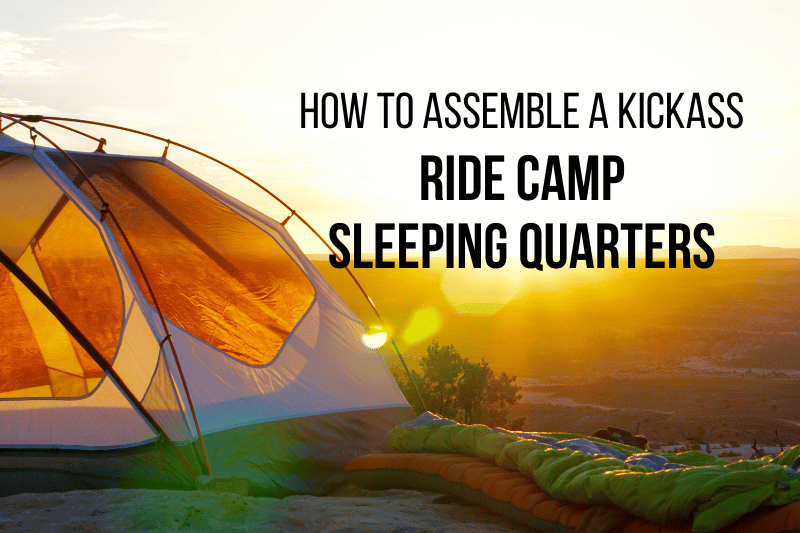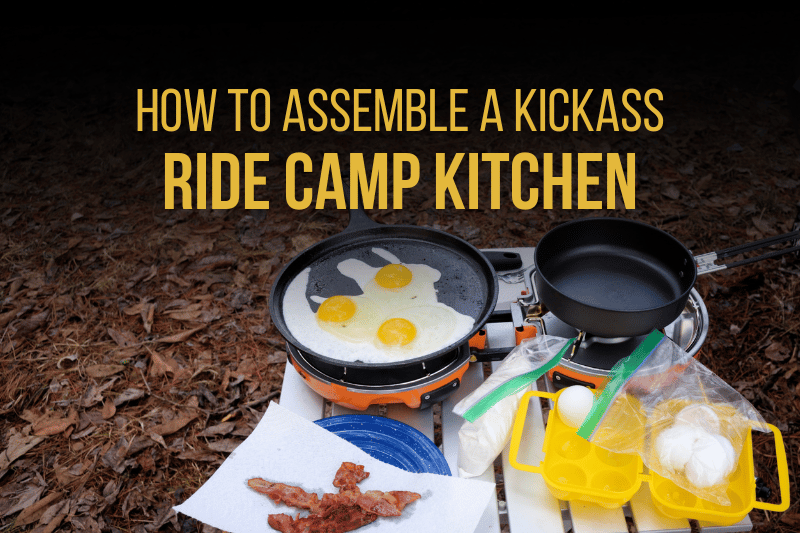If you’re an endurance rider without a living quarters trailer or truckbed camper, you’ll need to be creative when it comes to ride camp sleeping quarters. Your two, main options are: 1) set up a tent or 2) sleep in your horse trailer. You’ll also need to choose a good sleeping bag and pad. This post will cover pros, cons, and gear tips drawn from my decades of outdoor adventuring.
Set Up a Tent
Ah, the tent, that eternal favorite of Boy Scouts and wilderness wanderers! Tents can provide remarkably robust shelter in all weather, but they can also be intimidating to the uninitiated. Here’s what you need to know about this ride camp sleeping quarters option:
Tent Components
Most tents come in either two or three main parts: the tent itself, a rain fly, and a ground cloth made to protect the floor of the tent from moisture.
Depending on weather and privacy needs, you can usually choose whether or not to use your rain fly for any particular event. Using the fly with keep your tent’s interior warmer than going without. If precipitation or heavy dew is in the forecast, you’ll need to use it regardless. In a dusty camp situation, you might want to use the fly to help keep your belongings inside the tent clean.
Some tents have the ground cloth built right into the floor. Others don’t come with a ground cloth, requiring you to bring your own tarp for this purpose instead. If you’re using a ground cloth or tarp that didn’t come with your tent, make sure the edges don’t stick out beyond the floor of the tent itself. If they do, rainwater will puddle on top of the ground cloth and run directly under your tent. Tuck those edges in!
Tents are typically assembled using a system of poles. In older tents, these may be rigid, hollow aluminum poles that fit together. Modern tents typically feature flexible, fiberglass poles that create tension between the tent’s corners, reducing the need for supplementary cords to keep the structure erect.
Tent Styles
Tents come in a variety of styles, for purposes ranging from car camping with the family to backpacking in the Andes. Since you’re essentially “car camping” at a ride, and don’t need to worry too much about space and weight, you can likely get away with any tent you like. Cabin tents and dome tents are the most common styles.
Cabin tents are the largest option, and many are tall enough to let you stand up inside. This can be useful if you have mobility issues that make it difficult to change clothes in a semi-reclined position. Additionally, cabin tents have plenty of room for two or more people ~ often quite a few more. Some are even divided into two “rooms,” a sleeping space and a screened porch. The downsides of cabin tents are that they’re relatively cumbersome to haul, difficult to set up single-handed, and prone to catch a lot of wind due to their broad, flat sides.
Dome tents come in a variety of sizes. Most are easy for one person to set up, provided you know a few tricks, though it’s easier with two people. These tend to fare better than cabin tents in inclement weather, including wind. If set up correctly, they do a great job of shedding rain instead of letting it pool on the fly, which may eventually result in drips despite the excellent waterproof fabrics that are available these days. They’re also streamlined enough to handle moderate winds without difficulty.
Tent Size
Speaking of tent size, beware the old-fashioned method of marketing size by “man” capacity. A “four-man” tent may, technically, fit four people…but not comfortably. If you want any room to roll over or bring gear inside, halve the stated “man” capacity. For example, a typical “four-man” tent is comfortable for two.
Tent Tips
Generally speaking, a tent will be warmer than the back of your horse trailer. That thin fabric is surprisingly good at retaining heat, since you can seal yourself off from wind.
Assuming you are disciplined about keeping your tent door zipped except as you enter and exit, tents do a great job of keeping your sleeping and changing space bug-free. Leave your boots outside, and you’ll keep your space largely debris-free as well.
Some tents are designed to let you “fast pack.” Fast packing means setting up just the ground cloth and rain fly, without the actual enclosed tent. Depending on the design, this can create a private shelter from precipitation while preserving maximum airflow. You may also have enough room inside to set up a cot that wouldn’t fit in the tent itself. Fast packing is my method of choice for summer camping.
If you expect windy conditions, be sure to put plenty of heavy stuff inside your tent. Even the more streamlined models can easily uproot their stakes and go tumbleweeding across the countryside if insufficiently weighted down.
Speaking of stakes, carry a mallet along with your tent to make staking easier in hard ground. If you find yourself among too many rocks or roots to pound stakes effectively, you can sometimes lay a stake flat on the ground and pin it down with a heavy rock. Alternatively, use extra paracord to tie to roots, trees, or whatever is handy. A well-anchored tent will not only bear up better to wind and water, but it’ll also suffer less damage from repeated whipping in the breeze.
Tents must be completely dry when stored in order to avoid mildew growth. If you have to pack up your tent when it’s damp, remember to set it back up when you get home (garages are a good place for this) and let it air out.
Sleep in Your Horse Trailer
When I first started endurance riding, I slept in my stock-style horse trailer. This came with advantages and disadvantages, and I picked up a few tips along the way.
Your trailer will be cooler than a tent, which could obviously be good or bad. You can warm the space slightly ~ and block blowing rain ~ by hanging tarps to cover the windows. This works best if you weight the bottoms of the tarps to minimize flapping in the wind.
A dowel or PVC pipe as long as the tarp’s bottom edge, secured to the grommets, can serve as a core around which to roll the tarp for storage. Oil-treated canvas tarps, though expensive, are quieter than plastic tarps and nearly indestructible.
After you’ve shoveled out any “gifts” left by your horse during transport, you can lay another tarp on the floor to create a cleaner living space. Fold it “dirty side in” when you pack up and it’ll be ready for next time.
Whether you’re sleeping in your trailer or not, remember that it also offers an opportunity to get out of the weather. You can set up your kickass ride camp kitchen in there (well away from any flammables, obviously), hang a LED lantern, set up a table and chair, and relax.
Make Your Bed
Now that you have shelter, it’s time to make yourself a comfy bed. This will require some kind of sleeping pad, plus bedding to keep you warm. Let’s explore your options:
Cots
When it comes to camp sleeping, it’s hard to beat a good cot. This Roll-a-Cot is my favorite because it’s quick and easy to set up (once you get the hang of it), durable, and surprisingly comfortable. However, it is too large to fit inside most dome tents.
A variety of camp cots are available, including some smaller ones that may fit inside your tent. Read the reviews carefully, though, as some of them take considerable strength or finesse to assemble. Additionally, they’re bulkier and heavier than pads. You may conclude they’re not worth the trouble.
Sleeping Pads
Air-filled sleeping pads are another popular option.
I recommend choosing a quality pad from an outdoor gear retailer, rather than a cheap air mattress from Walmart. The latter typically aren’t made to withstand outdoor use, which may involve rough or sharp objects, extreme temperature changes, and other insults to the material. Additionally, good-quality pads offer greater comfort with less bulk due to the construction technologies they feature.
The downside of a sleeping pad is, of course, that you must inflate it. Nearly any pad can be inflated the old fashioned way, by blowing air into it with your mouth. However, I can’t think of anyone who actually enjoys that task.
Some products allow you to inflate them with hand pressure. (t’s good practice for CPR!) Others are billed as self-inflating, and generally work well if you’re okay with a relatively thin pad.
Alternatively, you can invest in an electric pump that’ll run off your truck battery (or you can bring along a smaller battery, like one you’d put in a lawn tractor, specifically for this purpose). Pumps come in a wide range of qualities and price points. You don’t need the high-end kind that’s designed to inflate a whitewater raft; a less expensive one will do. However, make sure your pump has an adaptor that will fit with the style of valve on your pad.
Inflation level for a sleeping pad is a matter of personal preference. I like mine inflated to the point that, when I lay on it and do a sit-up, my butt will just touch the ground when I’m about halfway up. Remember that the pad will soften a bit as the air temperature cools.
In hot weather, be sure you don’t leave your pad fully inflated while you go ride all day. You might come back to an exploded seam!
Finally, note that the lack of air circulation beneath a pad will make it warmer than most cots. Pro tip: For a cozy and luxurious option, try putting an inflated pad on top of your cot.
Bedding
Now, let’s keep you warm!
Sleeping bags are the obvious choice for camp bedding. When shopping for a sleeping bag, you’ll notice right away that you need to choose a bag with either down or synthetic insulation.
Synthetic insulation is heavier than down, but it has the advantage of retaining some warmth when wet, which down absolutely won’t do. If you decide to go synthetic, you’ll need to decide between short-staple insulation, which feels more like down, and continuous filament, which is heavier and stiffer but won’t shift or clump. Either type of synthetic insulation will lose a bit of its loft each time you crush it into a stuff sack, so your bag won’t last as long as a down one would.
Down is typically the more expensive option, not least because you get more warmth for the weight of the insulation. This is important if you’re going to be lugging your gear in a backpack, but less of a consideration in a ride camp situation. Down is very durable; a good bag last decades with proper care. However, it requires special cleaning techniques, which may be particularly relevant to those of use who are camping in dusty, horse-trampled environments.
If you decide to shop for a down bag, you’ll see that both goose down and duck down are available. Although goose is the highest quality, duck is also very good and costs less. When reading the specs on a particular product, don’t be tempted to conflate fill power with warmth. Fill power refers to the amount of space an ounce of down can fill; the higher the fill power, the less down it takes to fill the same amount of space, resulting in a lighter-weight product for the same warmth. If the bag’s weight doesn’t really matter to you, there’s no reason to pay for high fill power.
Temperature rating, on the other hand, is important. The specs on a particular bag may show two ratings: The “comfort rating” is the air temperature at which a person who sleeps cold will likely be comfortable. The “lower limit rating” is the air temperature at which a person who sleeps warm will likely be comfortable. On women-specific bags, comfort ratings are typically featured; men’s bags are more likely to feature lower limit ratings.
If you tend to get cold, choose a bag rated for a much lower temperature than you expect to experience in ride camp. Lab conditions, after all, don’t fully translate to the real world. Personally, I find that my 20-degree comfort rated down bag (a North Face Blue Kazoo) is actually comfortable down to about 30 degrees.
For a little extra warmth, plus a cleaner sleeping bag despite your trail-dirtied skin, I highly recommend adding a silk bag liner (I have this one by Rab). Cotton liners are also available at a lower price point.
Still stuck on that thing about women-specific bags? You don’t necessarily need a gendered bag. The women’s versions are usually shorter and shaped a bit differently to more comfortably accommodate the female physique. They also tend to feature extra insulation around the feet and core.
Any type of sleeping bag (regardless of special water-resistant treatments) is likely to collect condensation overnight. When this happens, don’t attempt to wipe it off. Instead, hang the bag outside or simply stretch it out on your cot or air mattress to dry. In clear weather, you can pull back your rain fly or tarps to increase ventilation inside your tent or trailer and encourage faster evaporation.
Regardless of the type of bag you choose, be sure to remove it from its stuff sack for storage at home. This will ensure that it dries thoroughly. It will also also protect the insulation from the clumping that occurs if the bag is kept in a crushed state for long periods.
Don’t want to purchase a sleeping bag? Consider the “lasagna method.” Take a stack of blankets to the ride and layer them one atop the next. Depending on whether you’re cold or hot, slide under more or fewer layers to get comfortable. The downside of this method is that blankets tend to be much heavier and bulkier than sleeping bags; on the bright side, they’re cheaper!
Now that you’re all set with a kickass ride camp sleeping quarters, don’t forget to check out the other posts in the Ride Camp Ready series:
1. How to Assemble a Kickass Ride Camp Kitchen
2. How to Pack and Cooler and Keep it Cold Longer Than You Ever Thought Possible
3. How to Get Better Sleep in Ride Camp
4. What to Eat on an Endurance Ride
You might also like
This page may include affiliate links, and I may earn a small commission (at no extra cost to you) when you purchase through these links. I only recommend products and services I think are helpful and useful. Thanks for helping me offset the cost of maintaining this blog as a free resource!




